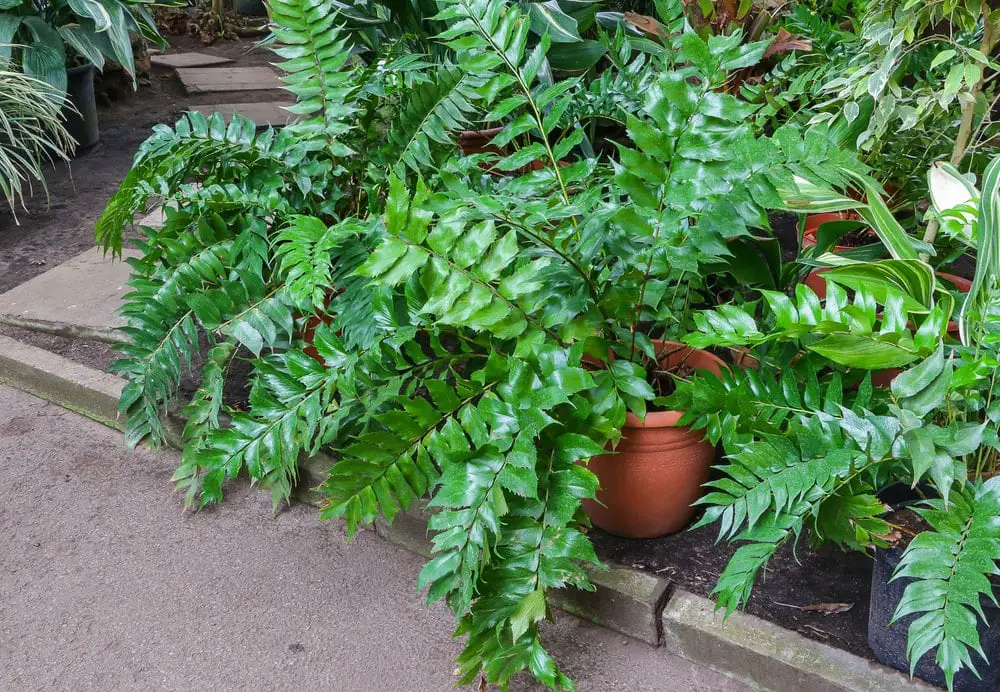Holly Fern, or crytomium falcatum, is a leafy plant that is native to eastern Asia.
This Hardy plant makes a beautiful addition to your indoor plant collection. It is tolerant of low moisture and humidity, making it an excellent plant to live indoors with running air conditioning. It is used outside as a filler plant and has been seen creeping through loose rocks and gravel.
Holly Fern Growth and Care Guide
1. Description
These plants are mostly used as a filler plant in a garden or outdoor trim, but several people love to keep these large leafy bushes inside pots in their homes as well. With large waxy frond that extends outwards, these plants resemble a traditional Holly bush, without the signature berries. With its obvious fern leaves growing in a saw tooth pattern down to the base, these plants are lovely and add a muted green, giving your home a clean, calming feel.
2. Climate
Holly Fern is USDA zone 6-10, and it thrives in places with low levels of humidity.
3. Soil
Holly Fern enjoys loose, moist soil with high acidic content, and rich in organic material. It enjoys pH levels of between 4.0 to 7.0.
4. Water
Most plants that can thrive in a dry environment can withstand without water for a long time. Holly Fern, however, is not in that category. Holly Ferns need to be watered on a regular schedule. Its extensive root system can stretch beyond the bounds of the visible plant, so the surrounding ground must be kept moist.
5. Light Requirements
Like several aspects of this plant, its light requirements are very lax. You may place this plant indirect to full to partial shade. Holly Fern is a perfect addition to a dark room in need of a pop of color. This is also useful for front or back gardens that don’t get exposed to much sunlight or trim a dark walkway that might otherwise look barren.

6. Temperature
Though it does not fair well in frigid temperatures, the Holly Fern is more inclined to flourish in a mid to low range. It prefers a temperature of 72 degrees during the day to below 60 degrees at night. In these mild climates, a Holly Fern is considered evergreen.
7. Potting
Because Holly Fern is low humidity tolerant, it makes a perfect house plant. When planting your Holly Fern, you want to make sure you have adequate spacing in your put, so make sure to get a large on since these plants can grow up to 2 feet tall. In a 12 to 18 inch pot, a Holly Fern would have more than enough room to flourish. You will want to ensure that the soil you choose is of high quality containing dense organic material. The Holly Fern needs to be watered and fertilized on a regular rotation. Keep out of extreme sunlight since it will cause scorching on the leaves.
8. Use in Gardens
As previously stated, Holly Fern is also popular in use as a garden filler. Its ability to stay low but grow wide and bushy is beneficial to anyone looking to take up space without giving their gardens a busy feel. The plants itself is easily managed and can leave a lovely undertone to a colorful garden. However, its root system is intricate and needs to be kept in mind when considering planting proximity.
9. Growth
A Holly Fern can be expected to grow at a medium rate. At full maturity, it can reach up to 24 inches tall and up to 3 feet wide. It also has a life expectancy of 10 years.
10. How to Help it Spread
Most people who use Holly Fern are doing so to take up space in their yard or gardens, and while it does a great job of that, it can be daunting to think of having to buy several plants if you need to cover a large space. Luckily with Holly Fern Spreading that preexisting plants are all too simple.
After digging the plant up, all one would have to do is cut the plant down the center, ensuring that all parts have an equal amount of the root system and replant in different areas. New plants will grow from those pieces. Also, by taking clippings from regular pruning, placing them in a pot with rich potting soil, you can cultivate a new plant.
11. Pruning
While this plant is chosen for its spreading ability, it does tend to get out of control. If you find that your plant is starting to have fronds that a yellow, brown, and dying, you will need to follow it back to the base and cut it back at the bottom, leaving the extra foliage where it is so it can protect the crown.
Is it Invasive?
Many have wondered because of the root situation if Holly Fern is invasive. It is not. It appears to spread out and take over it quite a compact bush and does not pose a threat to any surrounding plants.
Is it Poisonous?
The ASPCA marks Holly Fern as being non- toxic to both dogs and cats. It is safe to keep on the ground level when placed in your home and garden. Which is essential when considering what plants to keep in and around your house. They are also safe for people.
More like this: Cardboard Palm Growth and Care Guide
Conclusion
Holly Ferns can be a versatile and pretty plant. Its hardy exterior makes it perfect for a broad array of different environments. At the same time, its elegant feel will have you keeping it all over your house and yard. Its ability to be left in dark rooms and homes with constant central air makes it a favorite house plant. However, it does need a water and fertility schedule, or it will not thrive. If you keep plants, the Holly Fern is a necessity; not only is a beautiful, but it allows you to bring life into places that might not have otherwise allowed it. Its ability to fill space and its versatility makes it a must-have.
Also read:
Victoria is the owner and main author of hobby plants. She loves spending her free time in her garden planting and taking care of her plants. Victoria hopes you enjoy the content here!




![Mother Of Thousands Plant [Complete Plant Care Guide] Mother Of Thousands Plant [Complete Plant Care Guide]](https://www.hobbyplants.com/wp-content/uploads/2022/07/mother-of-thousands-plant-300x158.jpg)
![How Often Should You Water Pothos? [Complete Care Guide] How Often Should You Water Pothos? [Complete Care Guide]](https://www.hobbyplants.com/wp-content/uploads/2022/07/how-often-to-water-pothos-300x158.jpg)
![Can Snake Plants Live Outside? [COMPLETE CARE GUIDE] Can Snake Plants Live Outside? [COMPLETE CARE GUIDE]](https://www.hobbyplants.com/wp-content/uploads/2022/08/can-snake-plants-live-outside-300x158.jpg)
![Majesty Palm Plant Care: [Complete Beginner's Guide] Majesty Palm Plant Care: [Complete Beginner's Guide]](https://www.hobbyplants.com/wp-content/uploads/2022/08/majesty-palm-care-300x158.jpg)
![Exotic Angel Plant Care: [Complete Beginner's Guide] Exotic Angel Plant Care: [Complete Beginner's Guide]](https://www.hobbyplants.com/wp-content/uploads/2022/08/exotic-angel-plant-care-300x158.jpg)
![Do Coleus Like Sun Or Shade: [Complete Care Guide] Do Coleus Like Sun Or Shade: [Complete Care Guide]](https://www.hobbyplants.com/wp-content/uploads/2022/08/coleus-sun-or-shade-300x158.jpg)
![Snow White Waffle Plant: [Complete Care Guide] Snow White Waffle Plant: [Complete Care Guide]](https://www.hobbyplants.com/wp-content/uploads/2022/08/snow-white-waffle-plant-300x158.jpg)
![Waffle Plant Care: [Complete Beginner's Guide] Waffle Plant Care: [Complete Beginner's Guide]](https://www.hobbyplants.com/wp-content/uploads/2022/08/waffle-plant-300x158.jpg)